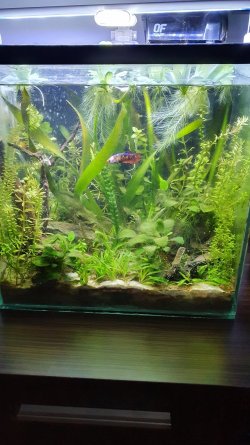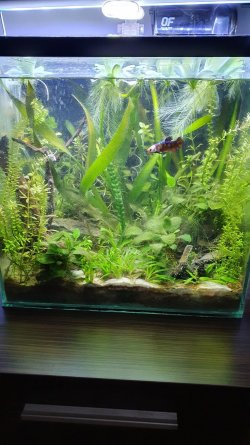Bicyclemaster
Fish Fanatic
Hey there. I have a 10G that's been running for about a year and a half. It's also heavily planted. At this poin I don't know what to do because when I started I got 7 panda cories, 5 of them died along the way and I never understood why.
My water is 24⁰C (75 F).
Nitrite and ammonia are 0
nitrate si 5-10
pH is 7.5
KH is 10 and GH is 8
It's always been like this, only one time when I didn't do a water change for 2 weeks the nitrate reached 20. I normally do 10% changes.
Some time ago I got another 7 cories, now from a breeder, because I thought that the first ones which I had bought from a petshop might had been sick (most people here say that the fish they get from petshops die). These new cories were fine for 1 month than they started dying one by one about one per week. 5 have died now and I really don't know what to do. Oxygen cannot be a problem beacuse I have both an air pump and an HOB running.
i thought about some possibilities: because there are so many plants maybe there isn't enough air circulation at the bottom of the tank and the water is more toxic. My substrate is aquasoil with a thin layer of sand on top and sometimes there are bubbles of air in the sand which from what I know can be very toxic to fish.
One last thing, there are 2 nerite snails in that tank that have been there since the beginning and a female betta. I'm sure the betta isn't the problem because I've never seen her attack any of the fish or snails.
My water is 24⁰C (75 F).
Nitrite and ammonia are 0
nitrate si 5-10
pH is 7.5
KH is 10 and GH is 8
It's always been like this, only one time when I didn't do a water change for 2 weeks the nitrate reached 20. I normally do 10% changes.
Some time ago I got another 7 cories, now from a breeder, because I thought that the first ones which I had bought from a petshop might had been sick (most people here say that the fish they get from petshops die). These new cories were fine for 1 month than they started dying one by one about one per week. 5 have died now and I really don't know what to do. Oxygen cannot be a problem beacuse I have both an air pump and an HOB running.
i thought about some possibilities: because there are so many plants maybe there isn't enough air circulation at the bottom of the tank and the water is more toxic. My substrate is aquasoil with a thin layer of sand on top and sometimes there are bubbles of air in the sand which from what I know can be very toxic to fish.
One last thing, there are 2 nerite snails in that tank that have been there since the beginning and a female betta. I'm sure the betta isn't the problem because I've never seen her attack any of the fish or snails.



